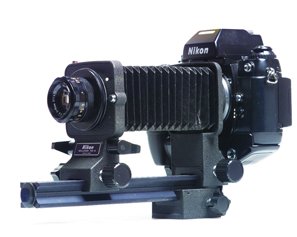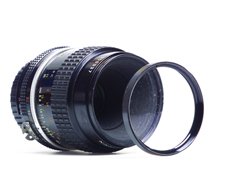articles/Lens/macrostarters-page1
Macro for starters - part 1 of 1 2 3
by Mike McNamee Published 01/06/2002

Macro photography has acquired a number of definitions over the years. The time was when no selfrespecting zoom lens would be without a zoom-macro facility. In truth these were often outside the definition of true macro but the 'Ad-men' cottoned on and the description stuck! "Close-up" photography is usually deemed to start at magnifications of greater than 1/10th full size, that is when the image on the film or CCD is 1/10th of its real size. The reason for this break point was simple. In those days, before aspheric lenses, most conventional designs were limited to working down to 10 focal lengths. Macro Photography really kicks in at 1:1 magnification, when the image and the subject are the same size.
Photomicrography kicks in beyond 10x full size, the point at which more complex optical trains are required, as in the compound microscope. Basically the "objective" lens creates an image inside the microscope and this is in turn examined with another lens, usually an eyepiece in the microscope but the image can be diverted to a camera for photography. This gets to be a dear do, your editor once spent £25,000 of your government's money on one microscope, in the days when that was at least three times his salary!
The Special Properties of Macro Photography There are a number of things you should understand about macro photography, which might help save you some disappointment. The main problem is that you have to get very close to your subject and that subject is big in the frame. If your heartbeat is causing you to move 2mm and you are working at 1:1 magnification your blur streak is going to extend over 10% of the frame. So rule number one is that you have to get yourself rock steady. If your subject is also moving (e.g. a flower in a gentle breeze) you have to tie the beggar up or surround it with a windbreak!
The second problem is Depth of Field (DoF). This is the length of the zone of sharp focus in front and behind your subject. Parts of the image outside the zone get gradually more blurred. DoF's can be very small. For example if you are photographing a small butterfly you may need to work at half full size. At this magnification your DoF at a typical aperture could be as low as 5mm, not enough to sharply render both the wing tips and body of a Common Blue. Depth of Field is increased by using a smaller aperture but you need to compensate with increased exposure time, just the thing you don't need in windy conditions when things are swaying about. The solution is to use flash and here, for once, things go in the photographer's favour. The closer you get to your subject the relatively stronger your flash gets. It is not unusual to employ effective apertures of f45 or f64 in close-up work. That requires an exposure of 1/8th of a second in sunlight (as much as a second in the woods) so you can forget hand holding! By comparison a £20 flashgun used at macro distance can easily pump out enough light for f32. All of these problems do not present so much difficulty in the studio for say jewellery work as you can bolt everything down solidly.

The Ways and Means
Use your Digital Camera
Today's digital cameras often have good macro facilities built in. The Nikon Coolpix 995 is particularly good and can focus down to 2cm. That's the thickness of your thumb but don't forget that no self-respecting butterfly is likely to let you get that close so you will have to be more modest with your demands!
The Close-up Lens
Also known as a supplementary or dioptre lens, these come in a number of strengths, typically 0.5 dioptre, 1, 2 or 3 dioptres. They normally screw onto the front of your lens. You may have to focus manually with a digital compact using one of these. A feature of using a Close-up lens is that the working distance remains constant at 1000 divided by the strength of the lens. Hence a 3 dioptre lens will have a working distance of 1000/3 = 333mm. The magnification you end up with depends on the focal length in use. If you zoom to a longer focal length the camera can stay where it is, the image just gets bigger. For our example we simple stuck the lens to a Coolpix 995 with Blu Tack. This is a £7 solution but it works quite well so don't knock it!
You are currently on page 1 Contact Mike McNamee
1st Published 01/06/2002
last update 09/12/2022 14:56:15
More Lens Articles
There are 17 days to get ready for The Society of Photographers Convention and Trade Show at The Novotel London West, Hammersmith ...
which starts on Wednesday 14th January 2026





